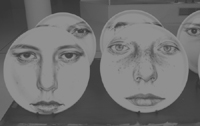See the little towns... Gubbio
.
Leah: What a climb. But we made it. In here.
.
 |
| Gubbio Civical Museum: Tablets III to VII |
Aria: We came here to see these?
.
Leah: Discovered by a farmer in a field in 1444.
.
Aria: What’s the writing mean?
.
Leah: Part Umbrian, written before Christ, a dead
language now, and part in Latin.
Aria: Another dead one.
.
Leah: But these are linguistic and cultural gems. The
largest complete Umbrian text in existence. And all about sacrificial customs
carried out in Gubbio here, two thousand years ago.
.
Aria: Sacrifices? Who did they kill?
.
Leah: Not people, but oxen, sheep, goats, pigs, puppies.
To protect the mountain, to protect the city. All carried out by a religious
brotherhood according to strict protocols. Bird flights determine auspicious
timing, some animals are sacrificed outside the city gates, some inside, how
the officiator is to be dressed, and how to conduct the ceremony.
________
Voice-over
A community which protects itself through sacrificial
rites is not so far back in the past. David Wootton writes in “The Invention of Science” that in the 1600s, even educated Englishmen, who might own as many as
a dozen books, believed in the power of witches, werewolves, magicians,
unicorns, alchemy, astrology and a flat earth. A few still do. Fascinating to
see how we thought before reason and science helped us make better sense of the
world.
...













No comments:
Post a Comment